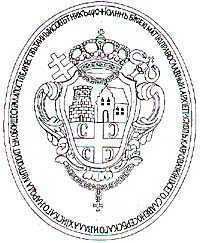Territory Habsburg Monarchy Established 1848 | Dissolved 1920 | |
 | ||
Sui iuris church Self-governing Serbian Orthodox Patriarchate | ||
The Patriarchate of Karlovci or Serbian Patriarchate of Sremski Karlovci (Serbian: Карловачка патријаршија (Српска патријаршија у Сремским Карловцима) or Karlovačka patrijaršija (Srpska patrijaršija u Sremskim Karlovcima)) was a patriarchate of the Serbian Orthodox Church that existed between 1848 and 1919. It was formed in 1848, when Metropolitanate of Karlovci was elevated to the rank of patriarchate. The Patriarchate of Karlovci existed until 1920, when it was merged with Metropolitanate of Belgrade and other Serbian ecclesiastical provinces to form the united Serbian Orthodox Church. The seat of the Patriarchate was in Karlovci (today Sremski Karlovci, Serbia).
Contents
History
At the May Assembly in Sremski Karlovci in 1848, the Serbs of the Habsburg Monarchy proclaimed the creation of the Serbian Vojvodina, a Serb autonomous region within the Monarchy. The metropolitan of Karlovci, Josif Rajačić, was also proclaimed "Serbian Patriarch", thus the Metropolitanate of Karlovci became a Patriarchate. The title of "Serbian Patriarch" given to Rajačić was confirmed by the emperor Franz Joseph I the same year.
This confirmation of Rajačić as the Serbian Patriarch, and Stevan Šupljikac as Vojvoda, was a political move made by emperor Francis Joseph I. He was confronted with revolution in his country and had difficulties subduing the Hungarians under Kossuth. Šupljikac and his Croatian counterpart, Josip Jelačić supported the Emperor against the Hungarians.
The position of Serbian Orthodox Church and Serbs in Austria and Hungary was regulated in reforms brought about first by empress Maria Theresa and later by emperor Joseph II. The Serbian Church-Public Council of 1769 regulated the Serbs and their Church status in a special paper named "Regulament" and, later, in "Deklaratorij" published in 1779. These acts regulated the life of the Metropolitanate of Karlovci until 1868. Emperor Francis Joseph I published a special edict regulating Serbian Orthodox Church affairs and his edict was in force until the unification of Serbian Churches in 1920.
The establishment of the Patriarchate in Karlovci was seen as restoration of Serbian unity in Austria and Hungary and the patriarch was even considered the ranking personage among the Serbs. Some authors claimed that actually the Habsburg dynasty in Austria founded the patriarchate of Karlovci.
In 1865, the Eastern Orthodox Romanians that were under jurisdiction of the Patriarchate of Karlovci were separated and transferred to the jurisdiction of newly created Romanian Metropolitanate of Sibiu. Process was accomplished by mutual agreement that included the transfer of the Eparchy of Arad and eastern parts of eparchies of Temišvar and Vršac.
In 1873, Bishopric of Chernivtsi in Bukovina, that was since 1783 under the spiritual jurisdiction of Karlovci, was elevated to the rank of Archbishopric when new Metropolitanate of Bukovinian and Dalmatia was created. New Archbishop of Chernivtsi gained jurisdiction over Serbian eparchies of Dalmatia and Kotor, that also were (until then) under spiritual jurisdiction of Karlovci.
Emperor Francis Joseph I exercised full control over the Patriarchate. In 1890, contrary to the Serb Church Congress ruling and the Orthodox tradition, he promoted Georgije Branković to the patriarchal throne. That way the emperor discredited the Church hierarchy in the eyes of laity and encouraged rise of the anti-clerical Serb People's Radical Party in Austria-Hungary.
The last patriarch, Lukijan Bogdanović, was murdered in 1913. After his death, the patriarchal throne remained vacant for the last seven years of its existence.
In 1920, the Patriarchate of Karlovci was merged into the newly united Serbian Orthodox Church under one Serbian patriarch residing in Belgrade.
Eparchies
It included following eparchies:
